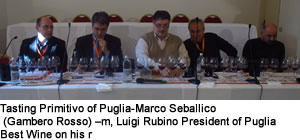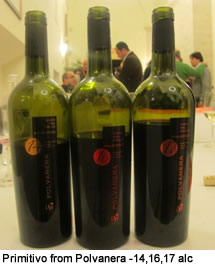 Apulia (known as Puglia in Italy), the second largest wine producing region of Italy after Veneto, is known predominantly for its big red wines. The flagship grapes of Puglia, are undoubtedly Primitivo and Negroamaro, with internationally lesser known Nero di Troia. Then there is Susumaniello- a local variety that was almost extinct in the nineties but has been revived during the last couple of decades and a few wineries like Cantine Due Palme and Cantine Rubino have helped revive it. Aglianico is yet another variety which is signature grape of Campania where it has found international fame as Taurasi docg wines. There has been an attempt to grow international varieties like Cabernet Sauvignon and Shiraz while Malvasia Nera is also used in some blends. Apulia (known as Puglia in Italy), the second largest wine producing region of Italy after Veneto, is known predominantly for its big red wines. The flagship grapes of Puglia, are undoubtedly Primitivo and Negroamaro, with internationally lesser known Nero di Troia. Then there is Susumaniello- a local variety that was almost extinct in the nineties but has been revived during the last couple of decades and a few wineries like Cantine Due Palme and Cantine Rubino have helped revive it. Aglianico is yet another variety which is signature grape of Campania where it has found international fame as Taurasi docg wines. There has been an attempt to grow international varieties like Cabernet Sauvignon and Shiraz while Malvasia Nera is also used in some blends.
Prince Primitivo- ‘Zinfandel’ of Italy
Story of this historic grapePrimitivo is fascinating and long. The early ripening variety was discovered to be the same as Zinfandel when a professor from UC Davies in California drank it in Bari, the Capital of Puglia and felt it tasted like the Zinfandel of California. He took the vines to UC Davies in 1968 for planting and the Research began. Prof. Carole Meredith proved in the nineties that the DNAs of both thewines were the same, says the Italian Primitivo expert and well regarded author Baldassarre who spoke at a seminar at the Apulia Wine Identity at Trani a few months back.
Disagreeing with the general perception that the origin of this grape is Croatia, he conceded that at first they had thought it to be the same but it is actually a Zinfandel and a local grape. Some Croatian scholars found a cross that has exactly the same DNA as Zinfandel (Zin) and Primitivo. Historical studies indicate that this vine does not come from Greece but from central Europe where Roman soldiers started planting vines in 281 AD, travelling from central Europe-to Balkan and reaching Puglia from where it went farther to the US. Anyhow, the research has given special incentive to the farmers in Puglia. When blended with other grapes from Italy and Europe it gives some special characteristics.
 In all likelihood it is an old variety called crljenak kastelanski planted at Radunic vineyard near Split on the Dalmatian coast in Croatia. The vines made their way from Croatia via the palace gardens of the Austro-Hungarian Empire in Vienna to Italy and the US via Italian immigrants who followed the gold rush to California in the mid-19th century. In all likelihood it is an old variety called crljenak kastelanski planted at Radunic vineyard near Split on the Dalmatian coast in Croatia. The vines made their way from Croatia via the palace gardens of the Austro-Hungarian Empire in Vienna to Italy and the US via Italian immigrants who followed the gold rush to California in the mid-19th century.
Primitivo shows different character in different geographical areas in Puglia. Gioia del Colle in the province of Bari is a stony area where soil is very thin and thick limestone rocks and some earth soil. Taranto- the Mandurian area is low and warm area near the sea-which does not go beyond 1200m height. Many soils have limestone, soil from debris, with less structure near the sea, while other areas have more limestone.
But winning area is considered to be Taranto, close to sea. It is very hot during day time while nights are fresh and cool. Salento, between Adriatic and Ionic Sea generates a special climate as if on the hills, with great difference in the day-night temperatures. Red soil, with clay and limestone provides structure to wine. Maturing of grape in Taranto and Manduria is earlier, while other areas harvest two weeks after.
Features of Primitivo
 Distinctive feature of Primitivo is its dark purple colour that goes towards ruby, garnet and orange. It is not very stable under the sun. Some producers keep it in oak barrels for a short time. There are aromas of extra-ordinary fruit that one likes immediately. Notes of red berries, black berries, cherry, raspberry, blackcurrants and prunes can be found in smell and taste. One can smell dried wild mint, thyme, almonds while the aged wine can feel like liquorice and tobacco; maturing in oak can give spicy notes. Sometimes you can taste spices from old vines even if they have not been kept in oak. It has a lot of sugar content so the alcohol level is high-it is usually 13% and can go up to 16 or even 17%- I tasted some at 17.5% !!. Tannins are not aggressive. The Primitivo is a grape you don’t have to wait for long after fermentation to appreciate-three years of aging is normally enough to understand and appreciate the wine. Distinctive feature of Primitivo is its dark purple colour that goes towards ruby, garnet and orange. It is not very stable under the sun. Some producers keep it in oak barrels for a short time. There are aromas of extra-ordinary fruit that one likes immediately. Notes of red berries, black berries, cherry, raspberry, blackcurrants and prunes can be found in smell and taste. One can smell dried wild mint, thyme, almonds while the aged wine can feel like liquorice and tobacco; maturing in oak can give spicy notes. Sometimes you can taste spices from old vines even if they have not been kept in oak. It has a lot of sugar content so the alcohol level is high-it is usually 13% and can go up to 16 or even 17%- I tasted some at 17.5% !!. Tannins are not aggressive. The Primitivo is a grape you don’t have to wait for long after fermentation to appreciate-three years of aging is normally enough to understand and appreciate the wine.
The price of this wine is also not outrageously expensive, giving good price-quality ratio. There is a distinct segment that likes ‘strong’ wine. Coupled with high alcohol strength and soft tannins makes it a good food wine for the segment used to drinking whisky with food. Indians have already been given the taste of Zinfandel courtesy Sula though most Zins in India only blush and do not show their potent qualities.
Primitivo from Puglia could find home in several vends and restaurants- the potent prince is waiting to be discovered by many macho men.
Subhash Arora
|